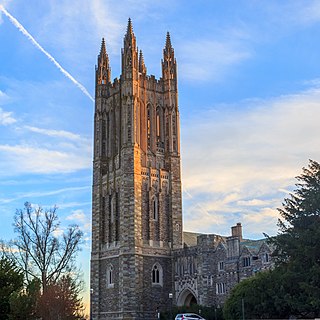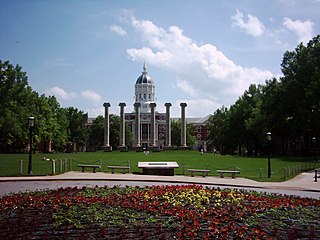
Collegiate Gothic is an architectural style subgenre of Gothic Revival architecture, popular in the late-19th and early-20th centuries for college and high school buildings in the United States, Canada, and Europe. A form of historicist architecture, it took its inspiration from English Tudor and Gothic buildings. It has returned in the 21st century in the form of prominent new buildings at schools and universities including those within the Ivy League.
The Mizzou Botanic Garden contains thousands of plants within the campus of the University of Missouri in Columbia, Missouri, United States. The Garden includes famous icons, such as Thomas Jefferson's original grave marker and the Columns of Academic Hall, and is open year-round, only asking for a small donation to visit.

Westminster College is a private college in Fulton, Missouri. It was established in 1851 as Fulton College. America's National Churchill Museum is a national historic site located on campus. The school enrolled 609 students in 2020.

Central Methodist University is a private university in Fayette, Missouri. CMU is accredited to offer masters, bachelors, and associate degrees. The school is affiliated with the United Methodist Church.

Stephens College is a private women's college in Columbia, Missouri. It is the second-oldest women's educational establishment that is still a women's college in the United States. It was founded on August 24, 1833, as the Columbia Female Academy. In 1856, David H. Hickman helped secure the college's charter under the name The Columbia Female Baptist Academy In the late 19th century it was renamed Stephens College after James L. Stephens endowed the college with $20,000. From 1937 to 1943, its Drama Department became renowned under its chairman and teacher, the actress Maude Adams, James M. Barrie's first American Peter Pan. The Warehouse Theater is the major performance venue for the college. The campus includes a National Historic District: Stephens College South Campus Historic District. It enrolled 593 students in Fall 2021.

The Missouri State Capitol is the home of the Missouri General Assembly and the executive branch of government of the U.S. state of Missouri. Located in Jefferson City at 201 West Capitol Avenue, it is the third capitol to be built in the city. The domed building, designed by the New York City architectural firm of Tracy and Swartwout, was completed in 1917.

Jesse Hall is the main administration building for the University of Missouri. Its dome has towered 180 feet above the south end of David R. Francis Quadrangle since its completion in 1895. In the lawn in front of Jesse Hall are The Columns, all that remains of its predecessor Academic Hall, which burned in 1892. The building contains the office of the chancellor, university registrar, graduate school, admissions, and financial aid. One of the most photographic landmarks in Missouri, the building was designed by Missouri architect Morris Frederick Bell, and is his largest surviving work. Jesse Auditorium had hosted graduations and many university functions over the years. The University Concert Series presents national and international concerts, Broadway shows, performers, bands, speakers, and theater to the largest auditorium in Columbia. As the former home of the School of Music, student performances occasionally happen. The building is the most prominent contributing structure to the David R. Francis Quadrangle National Register of Historic Places District. In 1922 "New Academic Hall" became "Jesse Hall" in honor of retiring University President Richard Henry Jesse.

The University of Missouri in Columbia, Missouri, was established in 1839. This later expanded to the statewide University of Missouri System.

David R. Francis Quadrangle is the historical center of the University of Missouri in Columbia, Missouri. Known as The Quad it is the oldest part of Red Campus and adjacent to Downtown Columbia at the south end of the Avenue of the Columns. At its center are six Ionic columns, all that remains of the original university building Academic Hall. Twelve buildings front the modern quadrangle including the domed main administration building Jesse Hall, the tallest building in Columbia. The Quad was designed and constructed by architect Morris Frederick Bell and his assistant William Lincoln Garver. It is named after Missouri governor David R. Francis. Eighteen structures, including the entire quad and most of Red Campus are listed as the Francis Quadrangle National Historic District. An obelisk, the original tombstone of Thomas Jefferson stands in front of the Chancellor's Residence. It was gifted to the University by Jefferson's descendants in recognition of Missouri's ties to Virginia. In front of Jesse Hall stand markers honoring university president Richard Henry Jesse and Missouri governor David R. Francis. Nearby is another obelisk in memory of Missouri's first U.S. senator David Barton, The Missouri School of Journalism is located at the northeast corner of The Quad, comprising Walter Williams Hall, Neff Hall, Gannet Hall, along with the Reynolds Journalism Institute. To the west, Switzler Hall is the oldest academic building on campus, though the Residence on the Quad, home of the chancellor, is the oldest building overall. The University of Missouri College of Engineering completes the west side. Pickard Hall is currently closed due to radiation contamination from turn of the century experiments. Swallow Hall was recently renovated and houses the Departments of Anthropology, Visual Studies and Ancient Mediterranean Studies.

Gideon Frank Rothwell was a U.S. Representative from Missouri. Born near Fulton, Missouri, Rothwell was graduated from the University of Missouri in Columbia. He studied law and was admitted to the bar in 1864, commencing practice in Huntsville, Missouri.
This is an incomplete list of historic properties and districts at United States colleges and universities that are listed on the National Register of Historic Places (NRHP). This includes National Historic Landmarks (NHLs) and other National Register of Historic Places listings. It includes listings at current and former educational institutions.
Red Campus is the historical core of the University of Missouri campus in Columbia primarily gathered around the David R. Francis Quadrangle. The area takes its name from the red bricks that make up most of the buildings including Jesse Hall and Switzler Hall. The campus contains 18 buildings on the National Register of Historic Places and area is nearly congruent with the Francis Quadrangle National Historic District. The Red Campus stands in contrast to the neo-gothic White Campus, which it borders on the east.

The University of Missouri–St. Louis (UMSL) is a public research university in St. Louis, Missouri. Established in 1963, it is the newest of the four universities in the University of Missouri System. Located on the former grounds of Bellerive Country Club, the university's campus stretches into the municipalities of Bellerive, Bel-Nor and Normandy. Additional facilities are located at the former site of Marillac College and at Grand Center, both in St. Louis city.

The University of Missouri is a public land-grant research university in Columbia, Missouri. It is Missouri's largest university and the flagship of the four-campus University of Missouri System. MU was founded in 1839 and was the first public university west of the Mississippi River. It has been a member of the Association of American Universities since 1908 and is classified among "R1: Doctoral Universities – Very high research activity". University of Missouri alumni, faculty, and staff include 18 Rhodes Scholars, 19 Truman Scholars, 141 Fulbright Scholars, 7 Governors of Missouri, and 6 members of the U.S. Congress. Two alumni and faculty have been awarded the Nobel Prize: alumnus Frederick Chapman Robbins won the Nobel Prize in Physiology or Medicine in 1954 and George Smith (chemist) was awarded the Nobel Prize in Chemistry in 2018 while affiliated with the university.
Stephen Hills was an architect notable for designing the original Pennsylvania State Capitol.

The Quad is an approximately 22-acre (8.9 ha) quadrangle on the campus of the University of Alabama located in Tuscaloosa, Alabama. Home to most of the university's original buildings, this portion of the campus remains the geographic and historic center of the modern campus. Originally designed by noted English-born architect William Nichols, construction of the university campus began in 1828, following the move of the Alabama state capital from Cahaba to Tuscaloosa in 1826. The overall design for this early version of the campus was patterned after Thomas Jefferson's plan for the University of Virginia, with its Lawn and Rotunda. Following the destruction of the campus during the American Civil War, a new Quad emerged in the late 19th and early 20th centuries. Different in form and function from the original design of the early 19th century, the modern Quad continues to fill its role as the heart of the campus. Although surrounded by academic and administrative buildings, only five structures are built directly on the Quad: the Little Round House, Tuomey Hall, Oliver-Barnard Hall, Amelia Gayle Gorgas Library, and Denny Chimes. The remainder of the space is occupied by a grove of trees on the west side and a great lawn on the east. A feature on the northwestern side, known as The Mound, is the site of the old Franklin Hall. A popular gathering place, the Quad is home to pep rallies, a bonfire during homecoming, and numerous day-to-day student activities.
8th Street, more commonly known as the Avenue of the Columns, is an urban street in downtown Columbia, Missouri. It connects the University of Missouri and Francis Quadrangle to the Boone County Court House and the Columbia City Hall. The avenue has long symbolized "town and gown" in this Midwestern college town. Sitting in the center of Francis Quad on the south are the 6 ionic columns of the former Academic Hall, aligned with these on the north are the 4 doric columns of the former Boone County Courthouse. William Jewell, the first mayor of Columbia, is said to be responsible for this decision. The domed Jesse Hall and its corinthian columns are also in the alignment. The street is also home to the Tiger Hotel, the Guitar Building, and the offices of the Columbia Missourian. Civic planning efforts have focused on in-fill development and beautification. In 2014, it became the center of a controversy over the decision to build single-use student housing despite mixed-use and ground floor retail being the focus of community planning. In 5 blocks, the street crosses three National Register of Historic Places districts.

The Sylvan Grove Theater and Columns, also known as the Sylvan Grove Theater or simply the Sylvan Theater, is a sylvan theater located on the University of Washington campus in Seattle, Washington. Within the theater are four 24 foot (7.3 m) tall Ionic columns from the original University building downtown, constructed in 1861. They are some of the oldest-standing architectural pieces in Seattle. It has been called "one of the most beautiful places on campus."

The Columns are the most recognized landmark of the University of Missouri in Columbia, Missouri. Standing forty-three feet (13 m) tall in the center of Francis Quadrangle and at the south end of the Avenue of the Columns, they are the remains of the portico of Academic Hall. Along with Jesse Hall, they are one of the most photographed sites in Missouri. The Columns have been at the center of many traditions and events including graduations, concerts, pranks, weddings, and protests. Mizzou's school song mentions the columns, and they have been the setting for a work of fiction. They are a contributing structure to the Francis Quadrangle National Historic District. The columns underwent preservation work in 2017.

The School of Music is an academic division of the University of Missouri in Columbia, Missouri. Its focus is the study of music, awarding baccalaureate, master's, and doctoral degrees as part of the College of Arts and Science. The institution's programs encompass composition, performance, conducting, music education, music history, musical theatre and musicology. Established in 1917 as the Department of Music, the school continues to play a prominent role in the cultural life of Missouri and is located in the Sinquefield Music Center, on the university's flagship campus in Downtown Columbia. The Fine Arts Building also houses classrooms, studios, and a recital hall. Its major performance venues are Jesse Hall, the Missouri Theatre, and Whitmore Recital Hall. The Missouri Tigers marching band, Marching Mizzou, performs at Faurot Field for Southeastern Conference football games. The school's ensembles have performed worldwide and can be heard weekly on the university's own KMUC 90.5 FM Classical, Mid-Missouri's classical music radio station. Alumni include singers Sheryl Crow and Neal Boyd, Canadian Brass founder Gene Watts, and jazz artist Mike Metheny.


















